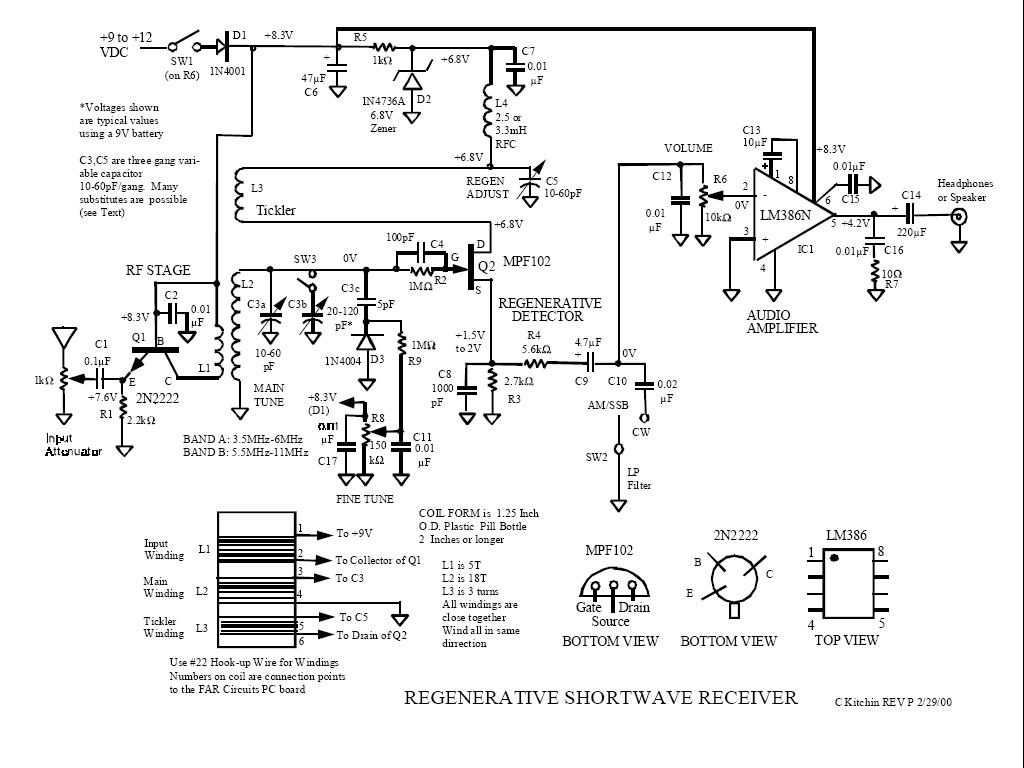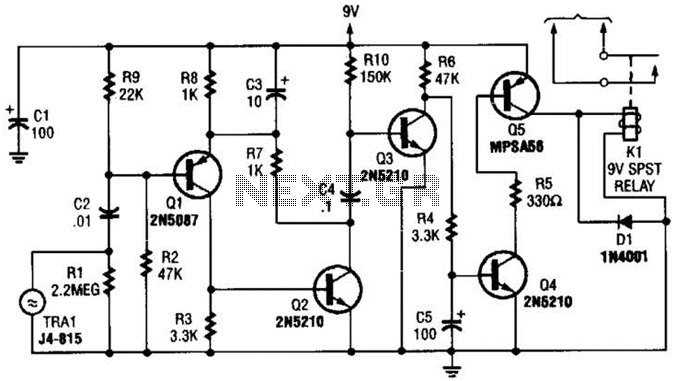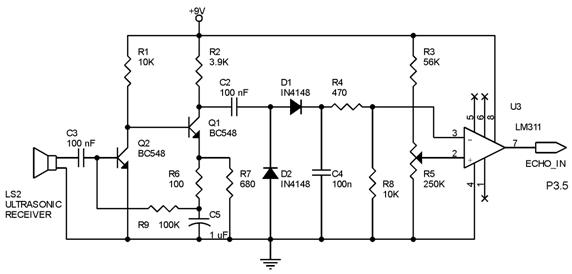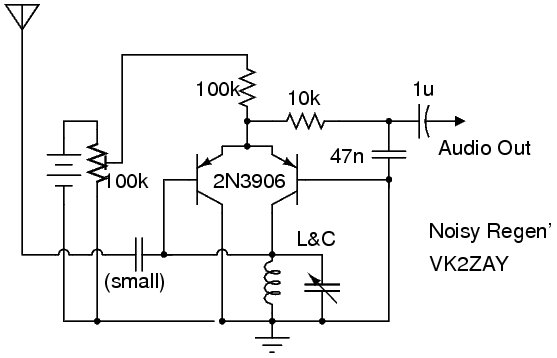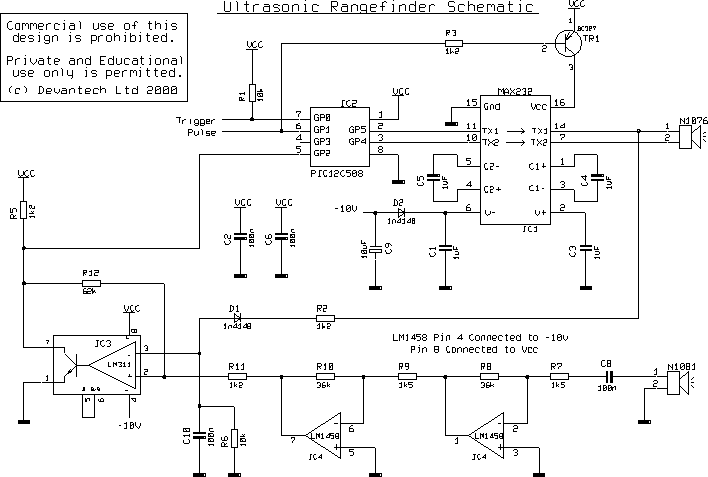
ultrasonic receiver
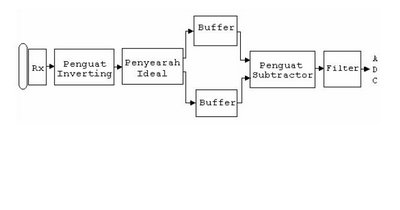
The barrier measurement method for distance is based on assessing the strength of a bound signal. A reflection wave is captured with an acceptor transducer, which emits a sine wave signal. The amplitude of this signal varies with the distance from the barrier to the transducer. The ultrasonic wave circuit strengthens the output of the acceptor transducer, which is unidirectional and filtered before being sent to an Analog-to-Digital Converter (ADC). The signal is processed using a precision rectifier circuit, supported by two buffer circuits and a subtractor amplifier to achieve full-wave rectification. The signal adapter circuit provides a total amplification of approximately 150 times, allowing detection of barrier distances up to 100 cm. The accompanying diagram illustrates the signal adapter's block structure. The inverting amplifier serves as the first stage with an amplification factor of about 46 times. The precision rectifier circuit is designed to have a gain of around 2 times, while the subtractor circuit has a gain of 1.5 times. A low-pass filter of second-order is implemented with a cutoff frequency of around 60 Hz to meet operational requirements. The output of the signal adapter circuit is a DC signal that is subsequently converted into a digital format. The diagrams illustrate various components, including the inverting amplifier, precision rectifier, buffer, subtractor amplifier, and filter utilized in this research.
The described electronic circuit for barrier distance measurement utilizes an ultrasonic transducer to detect the distance to a barrier by measuring the strength of the reflected signal. The acceptor transducer plays a crucial role in capturing the reflected ultrasonic waves and generating a sine wave output whose amplitude is directly proportional to the distance from the barrier. The circuit architecture is designed to enhance the signal processing and ensure accurate distance measurements.
The first stage of signal processing involves the inverting amplifier, which amplifies the sine wave signal by a factor of approximately 46. This initial amplification is essential to ensure that the subsequent stages can effectively process the signal. Following this, the precision rectifier circuit is employed, which utilizes operational amplifiers to rectify the AC signal into a DC signal while maintaining accuracy. The gain of this rectifier circuit is designed to be around 2 times, allowing for further enhancement of the signal.
Two buffer circuits are integrated into the design to isolate different stages of the circuit, preventing loading effects and ensuring that the signal integrity is maintained throughout the processing chain. The buffer circuits help in stabilizing the signal levels before they reach the subtractor amplifier.
The subtractor amplifier is utilized to perform a full-wave rectification of the signal, achieving a gain of 1.5 times. This stage is critical for converting the AC signal into a usable DC signal that reflects the distance measurement. The output from this stage is then fed into a low-pass filter designed to eliminate high-frequency noise, with a cutoff frequency of around 60 Hz, ensuring that the final output is smooth and stable.
The final output from the signal adapter circuit is a DC voltage that corresponds to the detected distance, which is then sent to an ADC for digital conversion. This conversion allows for further processing and display of the distance measurement, making the system suitable for various applications in distance sensing. The entire circuit is designed to provide high sensitivity and accuracy, making it effective for measuring distances up to 100 cm with a total amplification of approximately 150 times.Barrier measurement of distance method applied is with measuring strength of bound signal. Reflection wave is catch with an acceptor transducer. Acceptor transducer releases sine signal which the amplitude depended from barrier distance with transducer. Functioning ultrasonic wave Acceptor circuit strengthens, unidirectional and filters output of acceptor transducer before sent to ADC. Signal concurrent done by precision rectifier circuit assisted with two buffer circuit and an amplifier sub tractor to obtain full wave concurrent. Signal adapter circuit will give total reinforcement around 150 times and furthermost barrier distance of which still be detected is around 100 cm.
This picture shows signal adapter diagrams block. Amplifier inverting undertakes as first amplifier with reinforcement value around 46 times. Precision rectifier circuit designed has reinforcement around 2 times. Sub tractor circuit has reinforcement of 1, 5 times. Low filter circuit of order two designed to has frequency value cut-off around 60 Hertz to correspond to requirement. Output of signal adapter circuit is signal DC readily is turned into digital. Picture 5 up to showing each 9 is amplifier circuit inverting, precision rectifier, buffer, amplifier sub tractor and filter applied in this research.
🔗 External reference
The described electronic circuit for barrier distance measurement utilizes an ultrasonic transducer to detect the distance to a barrier by measuring the strength of the reflected signal. The acceptor transducer plays a crucial role in capturing the reflected ultrasonic waves and generating a sine wave output whose amplitude is directly proportional to the distance from the barrier. The circuit architecture is designed to enhance the signal processing and ensure accurate distance measurements.
The first stage of signal processing involves the inverting amplifier, which amplifies the sine wave signal by a factor of approximately 46. This initial amplification is essential to ensure that the subsequent stages can effectively process the signal. Following this, the precision rectifier circuit is employed, which utilizes operational amplifiers to rectify the AC signal into a DC signal while maintaining accuracy. The gain of this rectifier circuit is designed to be around 2 times, allowing for further enhancement of the signal.
Two buffer circuits are integrated into the design to isolate different stages of the circuit, preventing loading effects and ensuring that the signal integrity is maintained throughout the processing chain. The buffer circuits help in stabilizing the signal levels before they reach the subtractor amplifier.
The subtractor amplifier is utilized to perform a full-wave rectification of the signal, achieving a gain of 1.5 times. This stage is critical for converting the AC signal into a usable DC signal that reflects the distance measurement. The output from this stage is then fed into a low-pass filter designed to eliminate high-frequency noise, with a cutoff frequency of around 60 Hz, ensuring that the final output is smooth and stable.
The final output from the signal adapter circuit is a DC voltage that corresponds to the detected distance, which is then sent to an ADC for digital conversion. This conversion allows for further processing and display of the distance measurement, making the system suitable for various applications in distance sensing. The entire circuit is designed to provide high sensitivity and accuracy, making it effective for measuring distances up to 100 cm with a total amplification of approximately 150 times.Barrier measurement of distance method applied is with measuring strength of bound signal. Reflection wave is catch with an acceptor transducer. Acceptor transducer releases sine signal which the amplitude depended from barrier distance with transducer. Functioning ultrasonic wave Acceptor circuit strengthens, unidirectional and filters output of acceptor transducer before sent to ADC. Signal concurrent done by precision rectifier circuit assisted with two buffer circuit and an amplifier sub tractor to obtain full wave concurrent. Signal adapter circuit will give total reinforcement around 150 times and furthermost barrier distance of which still be detected is around 100 cm.
This picture shows signal adapter diagrams block. Amplifier inverting undertakes as first amplifier with reinforcement value around 46 times. Precision rectifier circuit designed has reinforcement around 2 times. Sub tractor circuit has reinforcement of 1, 5 times. Low filter circuit of order two designed to has frequency value cut-off around 60 Hertz to correspond to requirement. Output of signal adapter circuit is signal DC readily is turned into digital. Picture 5 up to showing each 9 is amplifier circuit inverting, precision rectifier, buffer, amplifier sub tractor and filter applied in this research.
🔗 External reference
